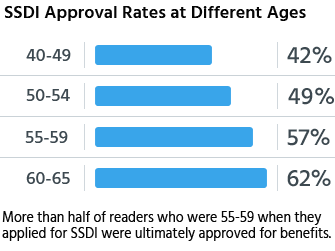When applying for Social Security Disability Insurance (SSDI), it is essential to understand how various factors can affect your prospects of approval.
The SSDI approval rate depends on factors like medical evidence, the applicant’s condition, and the availability of supporting documentation.
Other factors may include the applicant’s employment history, level of education, and transferable skills.
However, one of the most influential factors affecting approval rates is the applicant’s age.
Our article explores the SSDI approval rate by age group and provides information about the application procedure.

Understanding Social Security Disability Benefits
To collect Social Security benefits, a person must meet specific requirements set by the Social Security Administration (SSA).
Some of these factors include having a significant medical condition that prevents you from working, also known as substantial gainful activity (SGA), and the final one is having worked enough to have received enough credits through Social Security taxes.
The SSA oversees a program designed to help people afford the necessities of life and lead a dignified existence.
Social Security Administration Guidelines For Age
Although age doesn’t prevent a person from receiving disability benefits, it is considered by the SSA.
The Social Security Administration uses multiple age categories to determine how it incorporates age into its calculations.
Knowing the SSA’s rules about age can help candidates get through the process and improve their chances of being approved.
Within the Social Security Administration’s Medical-Vocational Guidelines, there are a total of five age brackets considered for Social Security disability benefits:
- Young adults aged 18 to 44
- Young adults aged 45 to 49
- 50 to 54-year-old middle-aged
- Advanced-age adults, 55 and older
- Adults nearing retirement age 60 and older

Younger adults aged 18 to 44
The approval rates for Social Security Disability Insurance (SSDI) applications from younger individuals are typically low.
Only 13.3% of all SSDI recipients were in the age bracket of 40 and under as successful beneficiaries as of June 2023.
The reason for the low level of approval is partly due to the idea that younger individuals have a better shot at using rehabilitation programs and adjusting to new job prospects despite their disabilities.
The Social Security Administration refers to those under 18 as “children.” As a result, the claims are also subject to different standards.
The Supplemental Security Income program (SSI) is only available to those under 19.
It can also be since SSDI is available only to those who have worked and contributed to the government system and are eligible.
The SSA also examines the jobs that younger applicants can do in the national economy. It can lower their chances of being approved.
If you want to learn everything there is to know about Social Security benefits for children, read our in-depth guide.
Young adults aged 45 to 49
Compared to younger adults, the number of people getting SSDI benefits may increase slightly among those 45 to 49 years old, with up to 17.6% of total beneficiaries.
Most people in the specified age group have worked for a long time, which can help them get SSDI benefits. They may also have more work credits, which makes it more likely that they will meet the minimum standards.
There are two methods by which adults under the age of 50 can be approved for disability payments from SSDI or SSI under the Medical-Vocational Guidelines:
- A medical condition is so severe that it qualifies as a severe disability (“medically disabled”)
- The condition prevents one from working full-time at any job (“vocationally disabled”).
Even if the medical records don’t have the details needed to meet a listing, Social Security can still find one disabled if the limitations prevent one from working at any job. The medical records and activities of daily living (ADLs) will determine the residual functional capacity (RFC).
50 to 54-year-old middle-aged
Adults in the middle age range, notably those between 50 and 54, have a significantly higher approval percentage for SSDI disability benefits than those in the lower age brackets.
The rough estimates have shown that almost 18.3% of all SSDI insurance recipients were in the particular age range, according to the statistics.
People 50-54 years of age have likely paid into Social Security long enough to be eligible for disability benefits; therefore, it’s unsurprising that this age group makes up many SSDI recipients.
Learn more about it in our dedicated article on disability benefits above 50.
Advanced-age adults, 55 and older
Applicants in the 55 and older age bracket are more likely to be approved for social security disability benefits and SSDI program payments since they may be declared disabled under SSA rules, even if they can do sedentary or light employment.
In addition, the “worn-out worker” criteria allow for the approval of SSDI claims from people of “advanced age.”
The grid system frequently leads to a classification of disability via one or more of the following:
- Only sedentary work is available to you.
- You do not possess a high school diploma.
- The jobs that you’ve held over the past 15 years are categorized as “unskilled,” “semi-skilled,” or “non-transferable work skills.”
The Social Security Administration has considered the rule because people of retirement age may have difficulty learning new skills and adapting to new jobs.
Adults Approaching retirement age 60 and older
People aged 60 to 66 made up 17.1% of all those receiving disability benefits, according to the statistics.
The SSA classifies individuals from age 60 to 66 as “Individuals of Advanced Age,” or full retirement age, and continues to use the same grid system, with the following exceptions:
- It is typically more difficult for older workers to acquire new skills and adjust to new environments.
- They have worked sufficiently for years and paid enough taxes to be supported.
Consequently, the SSA is not likely to require people in their 60s to undergo retraining to participate in a new profession or industry. Hence, approval rates are higher in the advanced age category.
They may also be able to apply for retirement benefits. Nevertheless, despite the fact that the Social Security Administration is in charge of both programs, it is crucial to keep in mind that retirement and SSDI benefits are separate.
Social Security disability benefits are converted to retirement benefits when recipients reach their maximum retirement age. The individual is not required to submit a separate application or undergo a new evaluation.
The benefits remain the same as the full retirement age benefit amount.
Also, each program has its eligibility requirements, application procedures, and rules. Learn the ins and outs of the Social Security Disability System for those 60 and older.
Borderline Age situations
Let’s say you apply for disability when you are 54 years and ten months old. Will the SSA use your age when you file your disability claim to determine which age group you belong to, or will they put you in the higher (and better) age bracket?
The SSA provides special consideration for situations involving an age cap. If a person is days or months away from entering a different age category, the claims examiner may evaluate the claim using the elder age category.
It is permitted only if evaluation under the older category yields a precise result for receiving disability benefits.
In this video, lawyer Antonio Bruni discusses the impact of age on a benefits application.
SSDI Approval Rates by Age Group
The number of Americans receiving disability benefits was close to 7.8 million in June 2022. That’s almost 4% of the adult population (18 and older).

The recent data for 2023 also shows that almost 71,259 SSDI benefits were granted in May this year.
These disability benefits are available to all individuals aged 18 and above, as they are based on work history and require some years of service.
The research also suggests that older individuals are more likely to qualify due to more working time, resulting in more work credits earned than younger individuals.
It can be because the Social Security Administration (SSA) estimates that people’s work abilities, education, and capacity to transition to other types of sedentary work decline with age.
Even the Center on Budget and Policy Priorities reports that disability increases with age. At age 50, the chance of getting an SSDI is twice as high as it was at age 40, and at age 60, it’s twice as high as it was at age 50.
That’s why it’s easier for seniors to qualify as disabled workers than for younger workers, whose education and experience would help them adapt to desk jobs.
For the sake of ease, let’s say you’re a male applicant who is 41 years old and has spent the last 16 years doing physically demanding unskilled construction work, like carrying heavy items and standing for an extended period.
Even if you can’t return to your old job because of your medical condition, the Social Security Administration won’t consider you disabled because you can still work at any sedentary job.
If you’re over 55 and experiencing the same impairments as the disabled person, you’ll be evaluated as disabled and eligible for disability payments.
How to Improve Your Chances of Approval for SSDI Benefits
To collect SSDI benefits, it’s essential to know what’s needed, and there are a few things you can do to improve your chances,
Provide Comprehensive Medical Evidence
First, ensure your application is complete, correct, and backed up by many medical records. Take careful notes on how your medical condition affects your capacity to work.
The greater the quantity and quality of your medical proof, the more convincing your argument will be.
Cooperate with the Social Security Administration SSA
It is essential to cooperate entirely with the SSA throughout the application procedure. Cooperation displays dedication to the process and boosts the possibility of a positive conclusion.
Be sure to update your application as needed, attend any planned medical exams, and respond quickly to requests for more information.
Seek Professional Guidance
Applying for Social Security Disability Insurance (SSDI) might be difficult if you don’t know your way around the system. If you want the odds to be in your favor, you should talk to a disability lawyer or advocate.
These experts know the system well, can point you to the right resources and can work with you to put together a complete and convincing application.
Stuck on the SSDI application or worried about the interview questions by the administrative law judge? Our article on disability trick questions will get you covered. Click to read.
A small video by the Youtube channel Disability Digest provides tips for SSDI approval rates by age. It says that you should work with an attorney, have your medical records checked, and keep a smooth application, which is crucial to getting approval.
Conclusion
Different age groups have different SSDI approval rates. Older adults generally have higher approval rates than younger and middle-aged people.
However, it is essential to consider that each individual’s circumstances play a significant role in understanding whether or not they will receive disability benefits in the future.
Regardless of age, all SSDI applicants should focus on providing solid medical evidence and a compelling case to support their claims. It is also recommended that you acquire the services of an SSDI advocate or attorney to help you through the application process.

